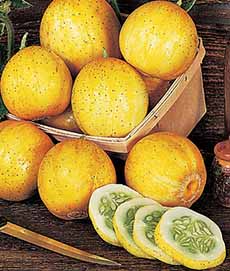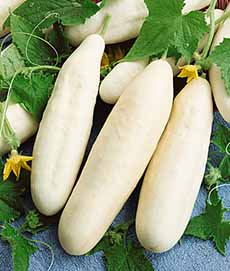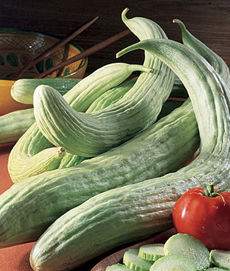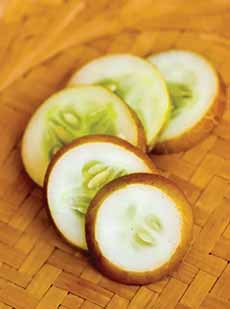Cucumber Cocktail, Garnish & The Different Types Of Cucumbers
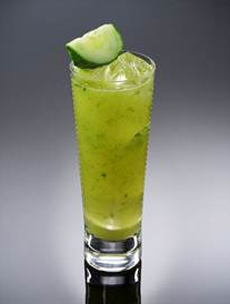 [1] Cool as a cucumber lemonade (photo © Hendricks Gin).
|
The different types of cucumbers are below, but we’re starting with a cocktail to celebrate National Cucumber Day, June 13th. Hendrick’s Gin sent us a cocktail recipe called Cucumber Lemonade. We enjoyed both the drink and the garnish and thought: Why don’t we use more cucumber garnishes? The Cucumber Lemonade recipe is below, but you can also use a cucumber garnish with: > The history of cucumbers. Ingredients For 1 Drink 1. COMBINE the first three ingredients in a tall glass. Add ice. 2. TOP with sparkling water, stir gently and garnish with a cucumber spear or wedge. Add them to your salads, and serve them as crudités. And check out the history of cucumbers. Growers define cucumbers in five categories: slicing, pickling, burpless, space savers, and specialty. > Armenian cucumbers (photo #4) are long, light green and heavily ribbed. They taste like a melon without the sweetness. Their ribbed shape makes interesting cross-sections when sliced. > Lemon cucumbers (photo #2) look like speckled lemons. White cucumbers (photo #3) are extra-crisp. > Crystal Apple cucumbers, heirlooms from New Zealand, have pale green, roundish fruits resembling Granny Smith apples. > Suyo Long is a traditional variety from China that delivers burpless, sweet ribbed fruits that can be used for slicing or pickling. Hybrids like Palace King have a ripples of yellow on emerald green skins. Here’s your homework: Go to a farmers market and look for specialty cucumbers. If you have a garden, check out the options and plan to plant at least one variety next year. By the way: cucumbers (Cucumis sativus) are a fruit, not a vegetable. They are members of the Cucurbitaceae family, which also includes watermelons, pumpkin, and zucchini, among others. |
|
|
_________________ *Botanically, cucumbers, Cumis sativus, are fruits. They are members of the same binomial genus as cantaloupe, honeydew, Persian and other melons. The difference between fruits and vegetables: Fact: Fruits are not necessarily sweet. Tomatoes are fruits, avocados are fruits, hot chile peppers are fruits, cucumbers and squash are fruits. Because they aren’t sweet, people think of them (and classify them in recipes and in produce departments) as vegetables. But by botanical definition, fruits have their seeds on the inside; the only exception is the strawberry. With fruits, the seeds, or pits, are contained in the fruit’s ovary sac. True vegetables have no “pit” or seed sac. CHECK OUT WHAT’S HAPPENING ON OUR HOME PAGE, THENIBBLE.COM.
|
||
